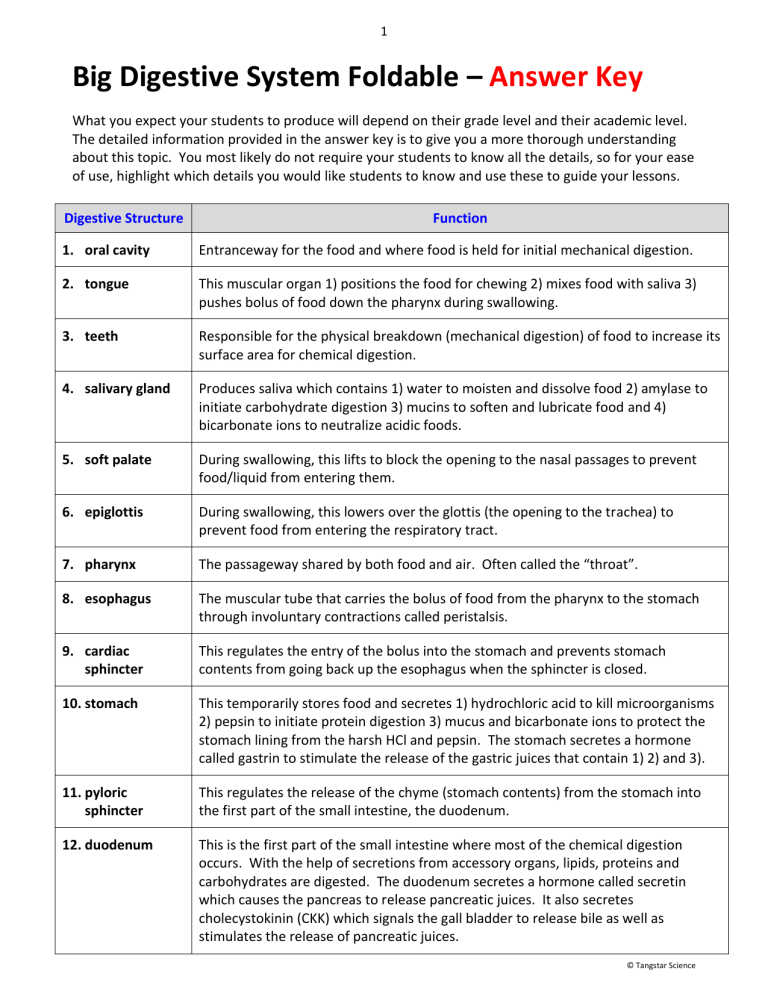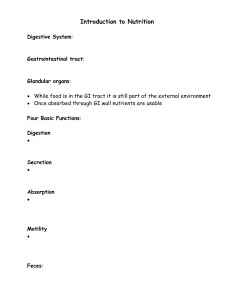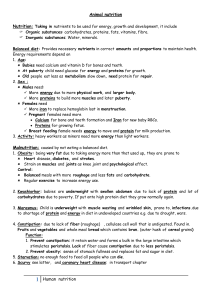
1
Big Digestive System Foldable – Answer Key
What you expect your students to produce will depend on their grade level and their academic level.
The detailed information provided in the answer key is to give you a more thorough understanding
about this topic. You most likely do not require your students to know all the details, so for your ease
of use, highlight which details you would like students to know and use these to guide your lessons.
Digestive Structure
Function
1. oral cavity
Entranceway for the food and where food is held for initial mechanical digestion.
2. tongue
This muscular organ 1) positions the food for chewing 2) mixes food with saliva 3)
pushes bolus of food down the pharynx during swallowing.
3. teeth
Responsible for the physical breakdown (mechanical digestion) of food to increase its
surface area for chemical digestion.
4. salivary gland
Produces saliva which contains 1) water to moisten and dissolve food 2) amylase to
initiate carbohydrate digestion 3) mucins to soften and lubricate food and 4)
bicarbonate ions to neutralize acidic foods.
5. soft palate
During swallowing, this lifts to block the opening to the nasal passages to prevent
food/liquid from entering them.
6. epiglottis
During swallowing, this lowers over the glottis (the opening to the trachea) to
prevent food from entering the respiratory tract.
7. pharynx
The passageway shared by both food and air. Often called the “throat”.
8. esophagus
The muscular tube that carries the bolus of food from the pharynx to the stomach
through involuntary contractions called peristalsis.
9. cardiac
sphincter
This regulates the entry of the bolus into the stomach and prevents stomach
contents from going back up the esophagus when the sphincter is closed.
10. stomach
This temporarily stores food and secretes 1) hydrochloric acid to kill microorganisms
2) pepsin to initiate protein digestion 3) mucus and bicarbonate ions to protect the
stomach lining from the harsh HCl and pepsin. The stomach secretes a hormone
called gastrin to stimulate the release of the gastric juices that contain 1) 2) and 3).
11. pyloric
sphincter
This regulates the release of the chyme (stomach contents) from the stomach into
the first part of the small intestine, the duodenum.
12. duodenum
This is the first part of the small intestine where most of the chemical digestion
occurs. With the help of secretions from accessory organs, lipids, proteins and
carbohydrates are digested. The duodenum secretes a hormone called secretin
which causes the pancreas to release pancreatic juices. It also secretes
cholecystokinin (CKK) which signals the gall bladder to release bile as well as
stimulates the release of pancreatic juices.
© Tangstar Science
2
13. liver
This organ produces bile to help physically break down lipids into smaller droplets
called micelles to increase the surface area for the chemical digestion that is to
follow. The bile is stored in the gall bladder until needed.
14. gall bladder
Stores bile and contracts in response to the presence of CCK to release the bile.
15. bile duct
A tube that helps transport the bile from gall bladder to the duodenum.
16. pancreas
This organ produces 1) bicarbonate ions to neutralize the acidic chyme in the
duodenum (converting it from pH 2 to pH 8) to prevent damage to the intestines 2)
various enzymes to aid in the chemical breakdown of lipids (lipases), proteins
(proteases like trypsin and erepsin) and carbohydrates (more amylase and various
disaccharidases).
17. jejunum
The second part of the small intestines where some of the digestion finishes off and
the absorption of digested nutrients begin. Contains finger-like projections called
villi and microvilli to increase the surface area of the intestinal lining to increase the
rate of absorption.
18. ileum
The third part of the small intestines where the absorption of nutrients continues
and is completed. Contains finger-like projections called villi and microvilli to
increase the surface area of the intestinal lining to increase the rate of absorption.
19. appendix
A vestigial structure that no longer plays a vital role in humans. It can often get
infected and inflamed causing a condition called appendicitis.
20. cecum
The first part of the large intestine.
21. large intestine
Responsible for 1) storing food waste 2) reabsorbing water from food waste 3)
housing a large population of symbiotic gut flora which aids in proper digestive
function (helps create bulk, creates B and K vitamins from food waste which can be
absorbed by the large intestines). The large intestines are broken up into several
sections in this order: cecum, ascending colon, transverse colon, descending colon,
sigmoid colon and rectum.
22. rectum
The last part of the large intestine which is responsible for storing feces until a bowel
movement voids the feces. It contains stretch receptors that activate when there is
enough volume in the rectum which stimulates the urge to void.
23. anus
A sphincter that regulates the release of feces from the rectum to the outside.
© Tangstar Science
3
Created by Anh-Thi Tang – Tangstar Science
Copyright © 2014 Anh-Thi Tang (a.k.a. Tangstar Science)
All rights reserved by author.
TERMS OF USE: This document is for personal use only and may only
be used by the original purchaser. Copying for more than one teacher,
classroom, department, school, or school district is prohibited.
Additional licenses can be purchased at a discount for others to use in
your department. This entire document, or any parts within, may not
be reproduced or displayed for public viewing. You may NOT
electronically post this product online including to teacher blogs,
classroom websites or school networks. Failure to comply is a
copyright infringement and a violation of the Digital Millennium
Copyright Act (DMCA).
http://www.teacherspayteachers.com/Store/Tangstar-Science
© Tangstar Science











